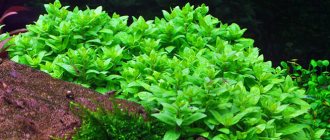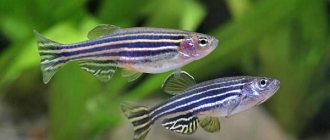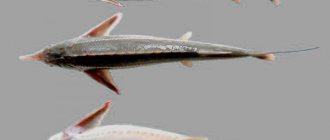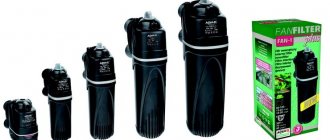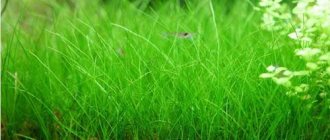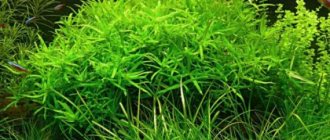Growing and care
The plant is considered easy to grow, which is why it is often used by novice aquascapers. It is very hardy, but in order to develop and maintain an attractive appearance it requires compliance with optimal parameters and growing rules.
Staurogine can be planted with plants that require low nitrate levels in the water. It absorbs compounds and purifies water well.
Water parameters for ideal maintenance
Staurogin is recommended to be grown in soft water or an aquatic environment with medium hardness, acidity within 4-7 pH (no more than 8 pH). Optimal temperatures are 20-30 degrees.
The supply of carbon dioxide is not considered mandatory, although the plant responds well to it - 20–40 mg/l is sufficient. If the aquarium is not overpopulated with fish, you can do without a soil siphon. Water changes are also required - 20-30% weekly.
Staurogyne repens is a hardy plant that feels normal with minor deviations in parameters, but in uncomfortable conditions it loses its decorative properties.
Lighting requirements
The lighting should be bright enough - 0.5-0.7 W/l, daylight hours should be 10-12 hours a day. In the absence of light, staurogyne appears weak and emaciated.
Soil requirements
It is better to choose soil with a small fraction and good aeration - small pebbles or sand, with a nutritious substrate.
A prerequisite is that the substrate must be of high quality, otherwise the result will be the opposite.
Staurogin grows slowly, like other hygrophiles, but with optimal parameters it demonstrates an average growth rate and quickly forms a dense green carpet.
Requirement for fertilizers
When growing a plant, you can do without fertilizers - applying a standard complex will be enough. Staurogine is sensitive to potassium and phosphate content. In the absence of these elements, “staurogyne disease” may occur - the foliage will begin to dissolve. To prevent it, it is necessary to add potassium, calcium sulfate and magnesium chloride to the water.
With enough fertilizer, the plant's foliage acquires a richer green tint and sometimes a beautiful glossy shine.
STAUROGYNE repens
TiMA
0
28 857
Share
The staurogyne plant grows naturally in the Amazon River in Brazil. This plant appeared in the collections of amateur aquarists relatively recently, but has already earned great popularity among both professionals and novice aquarists. The plant received such special attention due to its undemanding maintenance and very beautiful appearance.
Staurogyne repens is small in size and has a bright green color to its leaves, which measure up to 4 cm in length and about 2 cm in width. Its stem is quite powerful and reaches 10 cm in height. Usually the stem creeps along the surface of the soil and actively branches. The plant is very hardy and perhaps one of the most beautiful foreground aquarium plants. It is not difficult to maintain, it tolerates haircuts normally, after which its thickets become denser. Staurogin is suitable for cultivation in both large and tiny nano aquariums, where it grows to form an impressive bright green carpet. The root system is strong and well developed.
Water parameters that satisfy staurologin should be the following: temperature 20-28°C, hardness dH 4-14°, acidity pH 6.5-8.0. It is necessary to fertilize CO2 with a concentration of 5-9 mg/l, without which the plant grows very slowly. Periodic feeding with microfertilizers is desirable. In aquariums that are not overcrowded with fish, an additional bottom siphon is not required.
Lighting should be bright, intensity 0.5-0.7 W/l. The duration of daylight is 10-12 hours a day.
Stauroline grows in fairly dense rows. Its bushes branch very strongly, resulting in the formation of very picturesque green hills. It should be said that a hilly landscape forms on its own, without special cutting or denser planting. You need to mow the lawn very rarely, cutting only a few branches. Under acceptable conditions, the plant has an average growth rate.
When planting a plant in a new place, it is advisable to cut off its largest stems, which in turn are divided into 3-4 parts, planting them in small groups at a short distance from each other. After some time, having acclimatized in a new place, the staurogyne begins to produce stems in a horizontal direction, as a result of which a green lawn begins to form, which will eventually spread over the entire surface of the bottom.
Staurogyne propagates by daughter shoots that form after cutting off the tops. Due to the relatively slow growth, the frequency of haircuts should be no more than once a month.
Tags staurogyne, staurogyne repens
Found an error or a dead link?
Select the problematic fragment with the mouse and press CTRL+ENTER. In the window that appears, describe the problem and send it to the resource Administration.
Varieties
Staurogyne Low Grow Practically does not differ from creeping staurogyne, but has small leaves and is more demanding in terms of maintenance conditions. It does not tolerate high temperatures well and requires good water filtration.
Brown staurogyne A popular variety among aquascapers with excellent decorative characteristics - its stems are red-brown. When growing brown staurogyne, it is important to select fish carefully, as some herbivores like to eat its soft leaves.
Dwarf staurogyne There are several dwarf varieties of the plant, but they are quite difficult to grow, do not tolerate temperature changes, require fourteen hours of lighting and ideal water parameters.
Placement in an aquarium
Staurogyne repens is primarily used in aquariums as a ground cover plant. In aquarium design it is used in the foreground and middle ground. Can also be used in the background in nano aquariums. It is recommended to place plants in small groups. In order for it to maintain the chosen decorative shape, it is necessary to trim it, removing the tops.
In order to get a green carpet in the foreground of the aquarium, you need to follow the following technology. We plant several plants in a group at a minimum distance from each other. After the next trimming of the tops, we plant the cut cuttings nearby. The plant develops shoots that spread along the bottom, gradually forming a single carpet.
The plant looks good in combination with driftwood and stones. Staurogyne combines well with species such as hemianthus cubes and glossostigma. This combination is suitable for nano aquariums. Using Staurogyne repens you can create picturesque green hills in your aquarium. When planted tightly, the bushes begin to branch heavily. If you don't trim them for a while, the hills will appear on their own. In this case, it is necessary to cut the creeping staurogyne rarely, removing only the branches that spoil the composition. The plant calmly tolerates pruning, becoming thicker and more decorative as a result.
Staurogyne repens is equally suitable for aquariums of all sizes.
Staurogyne repens is a very useful plant. It purifies water from nitrates and helps maintain the purity of the aquatic environment in which it lives.
Tips and lifehacks
- When growing staurogyne, it is recommended to periodically test the phosphate and potassium levels in the water - this will help prevent disease and deterioration in appearance. The first sign of nutrient deficiency is small holes on the leaves.
- The plant goes well with other representatives of the ichthyoflora, but the founder of the AQUAYER company, Sergei Ermolaev, advises choosing your neighbors responsibly. Riccia, for example, consumes a lot of potassium, so it can create a deficiency for staurogyne.
- If staurogyne repens is growing too slowly or appears depleted, it is necessary to not only check the nutrient concentrations, but also increase the carbon dioxide supply and lighting.
- Sometimes when planting staurogyne, it turns out that its stems are too short, and the bush floats to the surface. For rooting, you can use a stainless steel weight and cotton thread or plastic staples with which the plant is pinned to the ground.
- Some herbivorous fish species gnaw the leaves of staurogyne - if such a phenomenon is observed constantly, only resettlement in separate aquariums can save the plant.
- Staurogyne repens can be grown both in aquariums and in humid environments. It takes root well in such conditions, and its leaves will not be elongated, like those of the aquarium variety, but oval.
Description
The shoots of creeping staurogyne reach a height of 10 cm, with a width of 5-10 cm. The leaf blades are 4.5 cm, have a lanceolate oval shape, and are green in color. The plant has a powerful stem up to 10 cm, which creeps parallel to the ground and branches well.
During flowering, white flowers appear. The closest relative of Staurogyne creeping hygrophila. At the same time, it is more compact and grows more slowly.
Staurogyne sp. Bihar 1 sprig
Serving size: 1 sprig.
Staurogyne sp. Bihar is a very strong and incredibly viable plant. Has high decorative properties. Will make its rich contribution to any underwater world. The upper leaves are striking with their clearly defined shape and deep cutouts, but the lower ones are not so memorable. Good lighting allows Staurogin Bihar to open up. Its leaves can range in color from dark green to brownish-pink. Even if your aquarium was previously gray and nondescript, with the appearance of this amazing plant in it, it will be transformed before your eyes! You'll see how color can affect the overall appearance. It will become more presentable, amazingly beautiful and indescribably bright. Depending on the conditions of detention, the leaves can change dramatically. Even on the same bush you can see completely different leaves. Bright and saturated on top, pale and gloomy below. Good lighting and regular supply of carbon dioxide will make your plant grow actively and without problems. Staurogin Bihar is not at all picky about any complex fertilizers, so you can do just fine without them. But, if you still want to feed your pet with useful substances. He obviously won't mind. The average height that you can achieve is no more than 20-25 cm. Such quite standard sizes of the plant will allow you to easily place it in the middle plan of the aquarium, thereby maximally attracting the attention of household members to it. Growth is calm and unhurried. It grows evenly throughout the year. This means that there will be no periods of slowdown or peaks of activity.
A tropical aquarium with a temperature of 24 to 28°C is ideal for this plant. Water parameters include: hardness - within 6.2-6.8 pH, and acidity - 8-12º. The lighting should be bright. As an artificial light source, it is possible to use LB type fluorescent lamps with a power of 0.5 - 0.7 W/l. Daylight hours - at least 12 hours. Sunbathing is also possible. But do not overdo it with direct rays, because you can get an ugly picture - algae. If Staurogin begins to produce vertical arrows, then you can cut them off and replant them in places convenient for you. Due to the fact that it does not grow very quickly, you can wait more than a month for a new haircut. Absolutely every self-respecting aquarist wants to buy Staurogin Bihar, because the conditions of keeping are not difficult, and the result does not take long to arrive. In just a few months you will be able to enjoy the absolute beauty of your instantly transformed aquarium.
